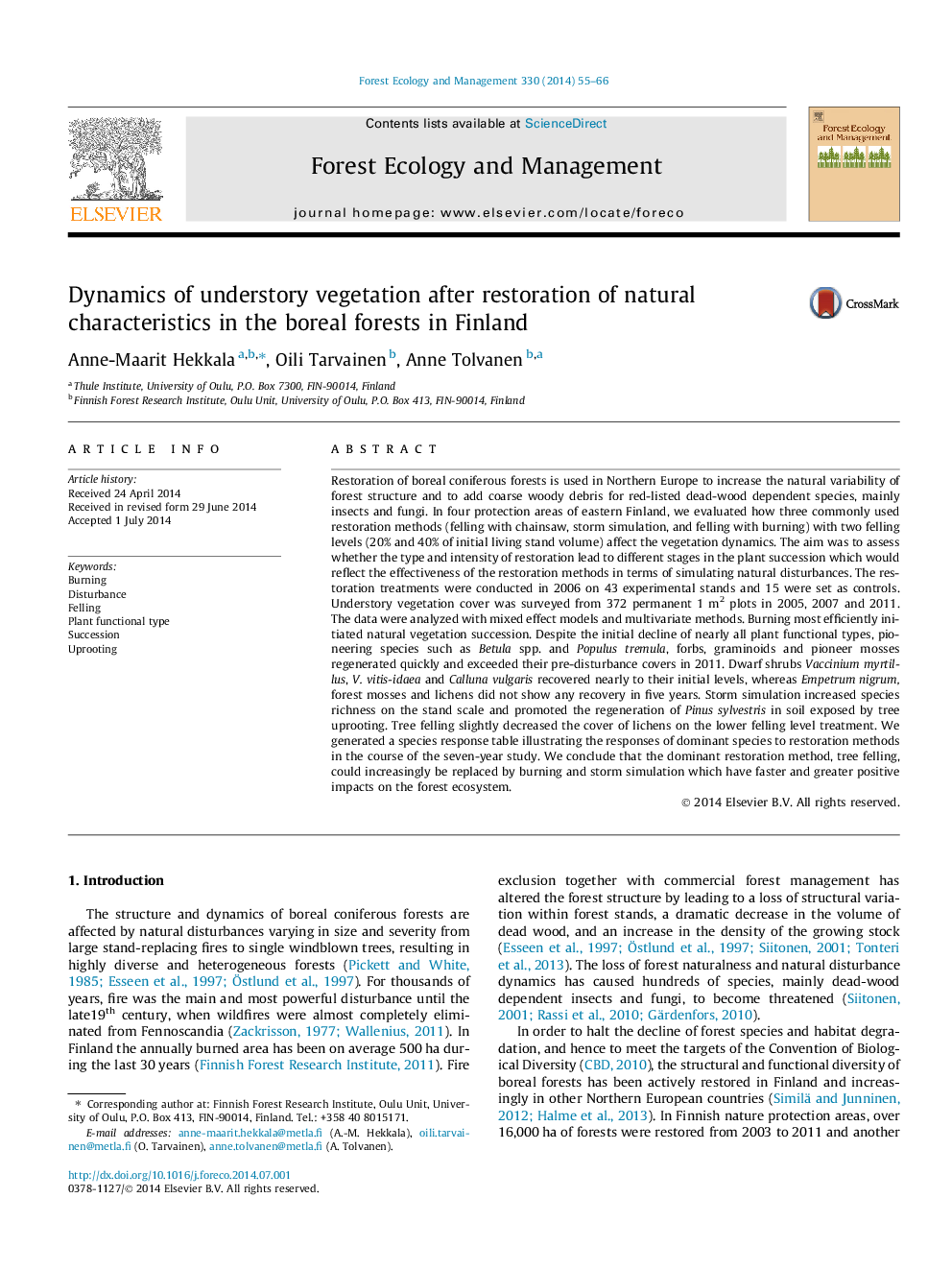| کد مقاله | کد نشریه | سال انتشار | مقاله انگلیسی | نسخه تمام متن |
|---|---|---|---|---|
| 6543289 | 159196 | 2014 | 12 صفحه PDF | دانلود رایگان |
عنوان انگلیسی مقاله ISI
Dynamics of understory vegetation after restoration of natural characteristics in the boreal forests in Finland
ترجمه فارسی عنوان
دینامیک پوشش گیاهی پس از بازسازی ویژگی های طبیعی در جنگل های بوم در فنلاند
دانلود مقاله + سفارش ترجمه
دانلود مقاله ISI انگلیسی
رایگان برای ایرانیان
کلمات کلیدی
موضوعات مرتبط
علوم زیستی و بیوفناوری
علوم کشاورزی و بیولوژیک
بوم شناسی، تکامل، رفتار و سامانه شناسی
چکیده انگلیسی
Restoration of boreal coniferous forests is used in Northern Europe to increase the natural variability of forest structure and to add coarse woody debris for red-listed dead-wood dependent species, mainly insects and fungi. In four protection areas of eastern Finland, we evaluated how three commonly used restoration methods (felling with chainsaw, storm simulation, and felling with burning) with two felling levels (20% and 40% of initial living stand volume) affect the vegetation dynamics. The aim was to assess whether the type and intensity of restoration lead to different stages in the plant succession which would reflect the effectiveness of the restoration methods in terms of simulating natural disturbances. The restoration treatments were conducted in 2006 on 43 experimental stands and 15 were set as controls. Understory vegetation cover was surveyed from 372 permanent 1 m2 plots in 2005, 2007 and 2011. The data were analyzed with mixed effect models and multivariate methods. Burning most efficiently initiated natural vegetation succession. Despite the initial decline of nearly all plant functional types, pioneering species such as Betula spp. and Populus tremula, forbs, graminoids and pioneer mosses regenerated quickly and exceeded their pre-disturbance covers in 2011. Dwarf shrubs Vaccinium myrtillus, V. vitis-idaea and Calluna vulgaris recovered nearly to their initial levels, whereas Empetrum nigrum, forest mosses and lichens did not show any recovery in five years. Storm simulation increased species richness on the stand scale and promoted the regeneration of Pinus sylvestris in soil exposed by tree uprooting. Tree felling slightly decreased the cover of lichens on the lower felling level treatment. We generated a species response table illustrating the responses of dominant species to restoration methods in the course of the seven-year study. We conclude that the dominant restoration method, tree felling, could increasingly be replaced by burning and storm simulation which have faster and greater positive impacts on the forest ecosystem.
ناشر
Database: Elsevier - ScienceDirect (ساینس دایرکت)
Journal: Forest Ecology and Management - Volume 330, 15 October 2014, Pages 55-66
Journal: Forest Ecology and Management - Volume 330, 15 October 2014, Pages 55-66
نویسندگان
Anne-Maarit Hekkala, Oili Tarvainen, Anne Tolvanen,
